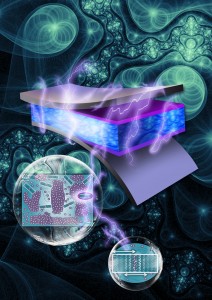Research from North Carolina State University reveals that solar cell efficiency is based upon a delicate balance between the size and purity of the interior layers, or domains. These findings may lead to better designs and improved performance in organic solar cells.
 A nanoscale interior of a solar cell
A nanoscale interior of a solar cell
Polymer-based solar cells are intended to have two domains, consisting of an electron acceptor and an electron donor material. Solar cell efficiency is based upon several factors: the ease with which excitons (the energy particles created by solar cells when light is absorbed) can travel to the interface of the donor and acceptor domains while retaining as much of the light’s energy as possible; and, once the charges are separated from the excitons, how efficiently separated charges travel to the device electrodes for collection.
In reality, however, these domains are not separate and pure, and there can end up being many more than two. Current processing methods create a complex, multi-domain structure, which impacts all of the factors involved in the solar cell’s efficiency.
NC State physicist Harald Ade and collaborators wanted to find out exactly how the solar cell’s complex structure impacts its performance. Using advanced soft X-ray techniques, Ade and colleagues from the Chinese Academy of Sciences found that the domains mixed in unusual and sometimes contradictory ways.
“Picture the solar cell’s two domain materials as cake batter with one vanilla layer and one chocolate layer,” Ade says. “Initially, the interfacial area – where the layers touch – is as large as your cake pan. As you mix the layers by pulling a fork though the batter to make swirls, more of the vanilla touches the chocolate and you create even more interfacial area. In a solar cell, more interfacial area serves to increase performance by increasing charge separation.
“However, if you continue to mix the layers, you get a uniform batter with less purity, which decreases solar cell performance as the charges recombine and are lost due to too much mixing.
“What we find is that in real devices the structure is similar to making swirls with different sized forks using a combination of big or small motions. This creates two length scales that can have different degrees of batter uniformity, leading to complex tradeoffs between size, purity and performance. Our task now is to understand these tradeoffs and find out how to engineer solar cells that take advantage of them.”
The paper, titled “Quantification of Nano- and Mesoscale Phase Separation and Relation to Donor and Acceptor Quantum Efficiency, Jsc, and FF in Polymer:Fullerene Solar Cells,” appears in Advanced Materials (DOI: 10.1002/adma.201400216). The research was funded by the U.S. Department of Energy, Office of Science, Basic Energy Science and the Chinese Ministry of Science and Technology.
Source: http://www.ncsu.edu